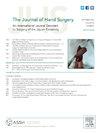腕管横截面积和腕横韧带厚度随时间变化的连续磁共振成像研究-一项解剖学研究。
IF 2.1
2区 医学
Q2 ORTHOPEDICS
引用次数: 0
摘要
目的:特发性腕管综合征(CTS)是一种常见的压迫性神经病变。年龄和女性是危险因素,但原因尚不清楚。本研究的目的是评估随着时间的推移是否存在可识别的影像学改变导致腕管面积(CTA)的减少。方法:对1998年至2021年多中心学术高等院校的数据库进行检索,确定了433例间隔至少5年的连续手腕磁共振图像(MRI)患者。56例符合纳入标准,有足够的胶片在相同的切片位置测量CTA和腕横韧带(TCL)厚度——腕管入口、腕带钩和腕管出口——由两名对彼此的测量结果不知情的观察者独立完成。在所有三个位置计算CTA和TCL厚度的变化率。结果:随着时间的推移,TCL厚度增加,而CTA厚度减少。入口CTA每年减少0.9 mm2 (95% CI: 0.34-1.5),出口CTA每年减少1.8 mm2 (95% CI: 1.2-2.5),钩部CTA每年减少1.6 mm2 (95% CI: 1.0-2.0)。三段TCL均以每年0.02 mm的速度增厚。高个子患者的CTA丢失率较低。结论:随着时间的推移,本组患者TCL增厚,CTA下降。TCL增厚约占CTA变化的一半,这表明这可能是导致这种变化的原因之一。腕管底肥大可能是CTA剩余变化的原因。这些结果是否可靠,是否可推广到一般人群,或者是否对CTS的病理生理有重大影响,目前尚不清楚。临床相关性:随着年龄的增长,CTA的少量下降和TCL的增厚发生。这是否是影响CTS发展的因素还有待进一步研究。本文章由计算机程序翻译,如有差异,请以英文原文为准。
Time-Dependent Change in Carpal Tunnel Cross-Sectional Area and Transverse Carpal Ligament Thickness Using Serial Magnetic Resonance Imaging Studies—An Anatomical Study
Purpose
Idiopathic carpal tunnel syndrome (CTS) is a common compressive neuropathy. Aging and female sex are risk factors, but the reasons are unclear. The purpose of this study was to evaluate whether identifiable radiographic changes resulting in a decrease in carpal tunnel area (CTA) over time exist.
Methods
A database search of a multicenter, academic, tertiary institution from 1998 to 2021 identified 433 patients with serial wrist magnetic resonance images (MRI) at least 5 years apart. Fifty-six met the inclusion criteria with adequate films to measure CTA and transverse carpal ligament (TCL) thickness at the same slice location—the carpal tunnel inlet, hook of the hamate, and carpal tunnel outlet—independently by two observers who were blinded to each other’s measurements. Rates for the change in CTA and TCL thickness were calculated at all three locations.
Results
Thickness of the TCL increased, whereas that of the CTA decreased over time. Inlet CTA decreased by 0.9 mm2 per year (95% CI: 0.34–1.5), outlet CTA decreased by 1.8 mm2 per year (95% CI: 1.2–2.5), and CTA at the hook of the hamate decreased by 1.6 mm2 per year (95% CI: 1.0–2.0 per year). The TCL thickened by 0.02 mm per year at all three sections. Taller patients had a decreased rate of CTA loss.
Conclusions
In this select cohort, TCL thickened and CTA decreased with time. TCL thickening accounted for about half of the variation in CTA, suggesting that this is a possible contributor to this change. Hypertrophy of the carpal tunnel floor may account for the remaining variation in CTA. The question of whether these results are reliable and generalizable to the general population, or a major influence in the pathophysiology of CTS, is unknown.
Clinical relevance
Small decreases in CTA and thickening of the TCL occur with aging. Whether this is a contributing factor in the development of CTS requires further study.
求助全文
通过发布文献求助,成功后即可免费获取论文全文。
去求助
来源期刊
CiteScore
3.20
自引率
10.50%
发文量
402
审稿时长
12 weeks
期刊介绍:
The Journal of Hand Surgery publishes original, peer-reviewed articles related to the pathophysiology, diagnosis, and treatment of diseases and conditions of the upper extremity; these include both clinical and basic science studies, along with case reports. Special features include Review Articles (including Current Concepts and The Hand Surgery Landscape), Reviews of Books and Media, and Letters to the Editor.

 求助内容:
求助内容: 应助结果提醒方式:
应助结果提醒方式:


